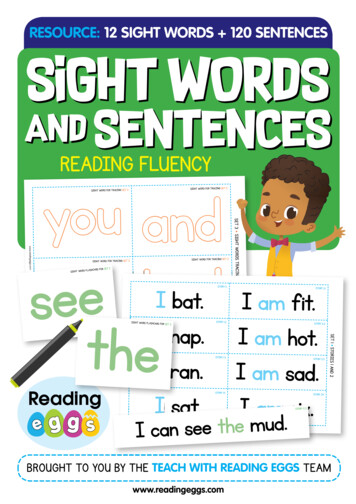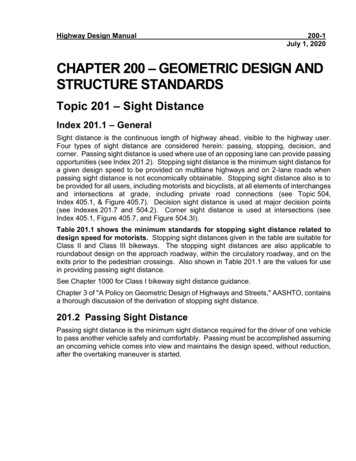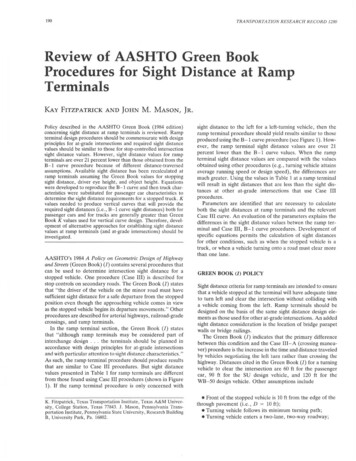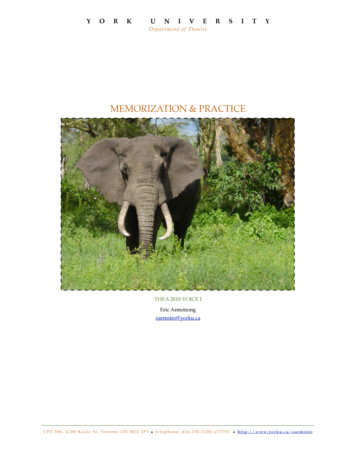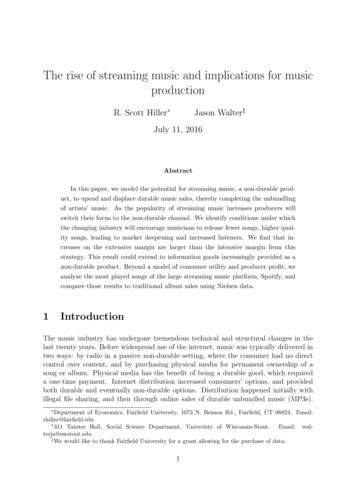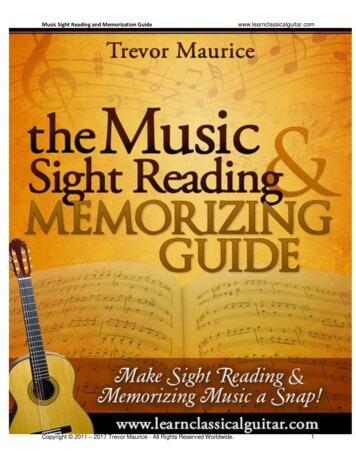
Transcription
Music Sight Reading and Memorization GuideCopyright 2011 – 2017 Trevor Maurice - All Rights Reserved Worldwide.www.learnclassicalguitar.com1
Music Sight Reading and Memorization Guidewww.learnclassicalguitar.comWARNING: This eBook is for your personal use only.You may NOT Give Away, Share Or Resell ThisIntellectual Property In Any WayAll Rights ReservedCopyright 2011 – 2017 Trevor Maurice. All rights are reserved. You may notdistribute this e-book in any way. You may not sell it, or reprint any part of itwithout written consent from the author, except for the inclusion of briefquotations in a review.DisclaimerThe information available in this e-book is intended to be a general information resource regarding thematters covered, and is not tailored as professional advice. It represents the view of the author at thedate of publication and current information available on this topic. Whilst every attempt has been made toverify the information provided in this e-book, neither the author not his affiliates/partners assume anyresponsibility for errors, inaccuracies or omissions. If professional assistance is required, the services of acompetent professional person should be sought. The fact that an organization or website is mentionedherein does not mean that the author endorses the information that the organization or website mayprovide or recommend.Copyright 2011 – 2017 Trevor Maurice - All Rights Reserved Worldwide.2
Music Sight Reading and Memorization Guidewww.learnclassicalguitar.comThe Music Sight Reading and Memorization GuideBy Trevor Maurice of www.learnclassicalguitar.comIntroductionIt’s a sad fact but many guitar players fear sight reading andmemorizing their pieces and try to avoid it at all costs. But in reality,sight reading and memorization is like anything else – the more youpractice it the better you will get!This guide is designed to give you the techniques that will leadto confidence in sight reading and memorization of your music.You need to form habits so that they become second nature.You do this by doing it consistently, day by day, week by week,year by year.If you’re like the proverbial “tortoise” (as in The Hare and theTortoise) you’ll find yourself gradually gaining mastery of notonly sight reading and memorization of your music, but ALL ofwhat you practice. Trying to do the big, quick “brain dump”never works. Rather it’s the “slow and steady” pace of thetortoise that always wins out. Which method are you going touse? Good! Let’s start with sight reading in Section 1 and moveon to memorization techniques in Section 2 Copyright 2011 – 2017 Trevor Maurice - All Rights Reserved Worldwide.3
Music Sight Reading and Memorization Guidewww.learnclassicalguitar.comSection 1 - Sight ReadingThere are many things you can do to improve your sight reading.I’ve actually enumerated 16 points below of a primary andsecondary nature to help you do this.THE most important is to practice sight reading on a daily basiseven if it’s only a line or two. If you do this you will improvemore quickly than employing a haphazard approach i.e. one dayon, three days off for example.But to be a good sight reader you also have to have knowledge.So, just what do you need to do to improve in a step by step,logical fashion?I’ve organized the following 16 primary and secondary tips youcan employ RIGHT NOW to improve your sight reading:Primary1.Performing DAILY sight reading practice;2. Read your music like a book first;3.Know the key signature;4.Be aware of the time signature and any time changeswithin the piece;5.Being able to count and clap the rhythm;6.Playing right through the whole piece the first time;7. Trying to read 1 to 2 bars ahead;Copyright 2011 – 2017 Trevor Maurice - All Rights Reserved Worldwide.4
Music Sight Reading and Memorization Guidewww.learnclassicalguitar.com8.Being able to spot the phrasing in music;9.Being aware of dynamic markings;10. Identifying intervals;11. Being aware of unusual syncopated rhythms;12. Recognizing repeated chord patterns and phrases;Secondary13. Trying to read your music in a legato fashion;14. Not always playing the strict tempo;15. Keeping your ears open for different parts and voices inthe music;16. Taking sight reading seriously.If you can perform these primary and secondary tasks well thenyou’ve got a great chance of reading your music fast and fluent!Let’s now talk about each one in more detail Copyright 2011 – 2017 Trevor Maurice - All Rights Reserved Worldwide.5
Music Sight Reading and Memorization Guidewww.learnclassicalguitar.comPrimary TipsTip 1: Sight read dailyThere’s nothing like daily practice at anything to get good at it –whatever that may be. Well, it’s exactly the same with sightreading. Daily, consistent practice will get you far, much fartherthan doing a whole lot of reading on one day and then missingfour days for example.It’s the same if you go to the gym. Regular practice will develophealthy, strong muscles. Your sight reading “muscle” is nodifferent – you need to exercise it! – Preferably daily.Chapter Take-Away: Sight read every day!How would you go reading this one Copyright 2011 – 2017 Trevor Maurice - All Rights Reserved Worldwide.6
Music Sight Reading and Memorization GuideCopyright 2011 – 2017 Trevor Maurice - All Rights Reserved Worldwide.www.learnclassicalguitar.com7
Music Sight Reading and Memorization Guidewww.learnclassicalguitar.comTip 2: Read music as a “whole” firstIf you had trouble sight reading “South Australia” in the lastchapter you might want to start treating your music like youwould a book. By that I mean, read the music as if it were abook from start to finish.Try to imagine where the notes are and where your fingers aregoing to be on the fret. This doesn’t matter if it takes a littlelonger by the way. Once you start doing this more and more itbecomes you guessed it, easier and easier! Becoming familiar with the work this way also leads to lessmistakes in the future and, because you get such a thoroughknowledge of the piece initially, it’s easier to work the piece upagain in the future after a lay-off.Copyright 2011 – 2017 Trevor Maurice - All Rights Reserved Worldwide.8
Music Sight Reading and Memorization Guidewww.learnclassicalguitar.comThis is the way the brain works – once something’s in there itisn’t going away, as they say! If you look at the end of this eBookyou’ll see a lot of sight reading examples in many keys. If youstart out by implementing all the techniques and tips I suggesthere you’ll become much more fluent in much less time.Think how one learns a new language. The one that’s successfulis the person who consistently and assiduously and intelligentlyapplies themselves to the task.Chapter Take-Away: Read your music as a “whole entity” beforeattempting to physically sight read it.Copyright 2011 – 2017 Trevor Maurice - All Rights Reserved Worldwide.9
Music Sight Reading and Memorization Guidewww.learnclassicalguitar.comTip 3: Know the key signatureWhat key (or keys) is the music in? Does it change key during thepiece? If you downloaded my other eBook called Music NotationPrimer, you would have worked through a section about keysand key signature’s. It’s a MUST read to get you started readingmusic notation. There’s no sense in working through this book ifyou can’t even recognize the basics of music notation.Just in case you didn’t get it then go here -Primer.htmlNow if you know how to read the key signature then it makesreading all the notes of the piece that much easier. For instanceif there’s a key signature of four sharps you’re going to be in thekey of either E major or C# minor Copyright 2011 – 2017 Trevor Maurice - All Rights Reserved Worldwide.10
Music Sight Reading and Memorization Guidewww.learnclassicalguitar.comYou might also remember from the music notation primer thatyou can determine a keys’ signature by looking at the last bassnote of the piece. If it’s an E then you’re in E major and if it’s aC# then you’re in C# minor.This one’s definitely in E major Copyright 2011 – 2017 Trevor Maurice - All Rights Reserved Worldwide.11
Music Sight Reading and Memorization Guidewww.learnclassicalguitar.comOther tell-tale signs for the piece being in a minor key are sharpswithin the music but not in the key signature i.e. the 7 th note ofharmonic minor scale is always raised so in C# harmonic minorthe B will be sharpened (played as an actual C note) You can see the accidental note on the B. Consequently, ALL theother B notes would be sharpened like this if you were in thekey of C# harmonic minor. It’s good to have a “heads-up” likethis because it’s going to be just that much easier to read and“anticipate” your music.Chapter Take-Away: Memorize all your key signatures – committhem to memory.Copyright 2011 – 2017 Trevor Maurice - All Rights Reserved Worldwide.12
Music Sight Reading and Memorization Guidewww.learnclassicalguitar.comTip 4: Understand the time signatureWhat is the time signature? Is it simple? Is it compound? Is itduple? Where are the accents falling in the music? Remember,the top number of the time signature means “how many” andthe bottom number means “what type” of notes. So, in a 2/4time signature the 2 would mean 2 notes per bar (or what addsup to 2 notes) and the 4 would equal quarter or crotchet notesfor example.Done that? Good! Well, just to make sure I want you to answerthe following questions about time signatures Write down how many notes and what type they are underthe following time signatures. The first one’s been done for you:Copyright 2011 – 2017 Trevor Maurice - All Rights Reserved Worldwide.13
Music Sight Reading and Memorization GuideHow many: FourWhat type: Quarter noteswww.learnclassicalguitar.comHow many:What type:How many:How many:What type:What type:How many:How many:What type:What type:Copyright 2011 – 2017 Trevor Maurice - All Rights Reserved Worldwide.14
Music Sight Reading and Memorization Guidewww.learnclassicalguitar.comHow many:How many:What type:What type:If you don’t understand time signature go back to the MusicNotation Primer and have a read before you continue here -Primer.htmlChapter Take-Away: Learn as many time signatures as you can tofacilitate quicker sight reading skills.Now we can move on Copyright 2011 – 2017 Trevor Maurice - All Rights Reserved Worldwide.15
Music Sight Reading and Memorization Guidewww.learnclassicalguitar.comTip 5: Clap rhythm and count timeThis will highlight the rhythm and give you a “heads up” whenplaying through the music as to where the “difficult” rhythmpassages may be. It will also reveal the ‘character” or “feel” of apiece of music thus making it easier to interpret and play.For instance the following piece will be counted: 1, 2, 3 & 4 andyou could clap it easily That’s five claps in the rhythm. If you were also marking thebeat with your foot the “and” of beat 3 is when your toes are inthe air at the highest point of the movement of your toes.Copyright 2011 – 2017 Trevor Maurice - All Rights Reserved Worldwide.16
Music Sight Reading and Memorization Guidewww.learnclassicalguitar.comYou see, there are “ands” for every beat when we’re tapping ourtoes or clapping but the rhythm is what you actually clap, sing orplay. That’s the difference. Here’s what it is theoretically like Chapter Take-Away: Always clap or tap the rhythm before youactually sight read your music.Copyright 2011 – 2017 Trevor Maurice - All Rights Reserved Worldwide.17
Music Sight Reading and Memorization Guidewww.learnclassicalguitar.comTip 6: Play from start to finishI’ve seen too many students in the past stop when they make amistake and then return to the beginning to start again. Theycan also do this several times in a sitting!It has to be one of the most counterproductive ways to learn tosight read. For one, you never really get through the music andtwo, you’re actually practicing mistakes and making it part ofyour subconscious conditioning. The best way is to go throughfrom start to finish the first time. Yes, you might make somemistakes but you won’t be ingraining them in your performance.But when you sight read all the way through the first time it getsyou into a good habit and makes you more fluent when sightreading in the future. Let’s try it right now! Go and get yourguitar and try this without stopping Copyright 2011 – 2017 Trevor Maurice - All Rights Reserved Worldwide.18
Music Sight Reading and Memorization Guidewww.learnclassicalguitar.comCheck if you were right by listening here oppingChapter Take-Away: Always read through to the end of yourmusic without stopping the first time round.Copyright 2011 – 2017 Trevor Maurice - All Rights Reserved Worldwide.19
Music Sight Reading and Memorization Guidewww.learnclassicalguitar.comTip 7: Read 1 to 2 bars aheadYou should try, even if you haven’t done much sight reading,practicing to read about 1 to 2 bars ahead of where you’reactually reading. Reading ahead like this gives you “time”.It’s actually an advanced skill and that’s what you’re headingfor. When I said it gives you time, it gets you into a good habit sothat when you’re performing or playing with a partner you’ll befar better off if something “untoward” happens. You’ll be out infront and buying time, as it were.It also helps with confidence to be able to read ahead.Remember what it was like in school when you could readahead of the teacher in group reading tasks. When you realizedyou could do this it was a real buzz! It’s the same when you readmusic too Copyright 2011 – 2017 Trevor Maurice - All Rights Reserved Worldwide.20
Music Sight Reading and Memorization Guidewww.learnclassicalguitar.comThe sight reading examples at the end of this eBook start prettysimply. You should try to use these to start to get in the habit ofreading 1 to 2 bars ahead. This is a good habit to get into as youcan often “anticipate’ mistakes before they happen. Really goodmusicians (with lots of practice behind them) often read wholephrases ahead.Try it with this very short piece Chapter Take-Away: Try to read 1 to 2 bars ahead at all times.Copyright 2011 – 2017 Trevor Maurice - All Rights Reserved Worldwide.21
Music Sight Reading and Memorization Guidewww.learnclassicalguitar.comTip 8: Look for natural “phrases”If you try to compare your music to a singer you’ll realize thereare always phrases (a unit of melody or group of notes insuccession) in music. And at the end of each natural phrase iswhere the singer would take a breath.The guitarist also has to “take a breath” when playing music asthis will indeed make your interpretation more musical and thewhole piece “breathe” in general. In other words, it won’t havethe feeling of being rushed, or stilted, or in some other wayunnatural and unpleasant to the ears.Well, if you could detect the natural phrases in music you’dstand a better chance of playing and sight reading moreaccurately and successfully.Copyright 2011 – 2017 Trevor Maurice - All Rights Reserved Worldwide.22
Music Sight Reading and Memorization Guidewww.learnclassicalguitar.comSo what do you look for in phrases? Often times the music willhave “slurs” over it. These are markings that look like ties BUTcover a series of notes and mean that you play all the notesunder the markings in a legato (smooth and connected) way.These are NOT to be confused with guitar slurs which are thehammer-on, pull-off and trill. Here is a piece from the beginnerseries that has slur marks over the phrases Also, here’s a piece that doesn’t have phrase markings but youcan definitely see the phrases clearly Copyright 2011 – 2017 Trevor Maurice - All Rights Reserved Worldwide.23
Music Sight Reading and Memorization GuideCopyright 2011 – 2017 Trevor Maurice - All Rights Reserved Worldwide.www.learnclassicalguitar.com24
Music Sight Reading and Memorization Guidewww.learnclassicalguitar.comYou can see where the half-notes are where you “take a breath”which is also the end of each phrase. Look for these phrases andyour sight reading will be much more fluent and accurate.Chapter Take-Away: Phrase markings can cut down your readingtime markedly if you understand them.Copyright 2011 – 2017 Trevor Maurice - All Rights Reserved Worldwide.25
Music Sight Reading and Memorization Guidewww.learnclassicalguitar.comTip 9: Be aware of dynamic markingsLoudness and softness and all the way in between! That canmake all the difference to the way a piece of music sounds. Youare the creator of the music in the sense that you “bring it alive”with proper and tasteful dynamics. If you practice this evenwhen sight reading, you’re more likely to do it when performingbecause you’re already in the habit There are many, many dynamic markings in music notation andit’ll take a while before you commit them all to memory. Hereare just a few I can implement with my Finale music softwareprogram Copyright 2011 – 2017 Trevor Maurice - All Rights Reserved Worldwide.26
Music Sight Reading and Memorization Guidewww.learnclassicalguitar.comIf you want practice in learning these dynamic markings gohere ologyChapter Take-Away: The more dynamic markings you know andunderstand the easier it is to sight read music.Copyright 2011 – 2017 Trevor Maurice - All Rights Reserved Worldwide.27
Music Sight Reading and Memorization Guidewww.learnclassicalguitar.comTip 10: Identify intervalsBefore you play a piece of music for the first time, try to identifyknown melodic and harmonic intervals. This will make it easierto play “cleanly”. If you remember from the Music NotationPrimer, an interval was the distance from one note to another ina chord or melody “An interval is always measured from the lower note to thehigher one. You also name its distance in numbers and thequality or type of distance. Let’s start with the type.You can have a: unison (same note); second; third; fourth; fifth;sixth; seventh; eighth (a.k.a. octave) etc. Here is an example ofnote intervals from the lower to the higher note.”Copyright 2011 – 2017 Trevor Maurice - All Rights Reserved Worldwide.28
Music Sight Reading and Memorization Guidewww.learnclassicalguitar.comSee if you can quickly mentally identify these intervals from the“home” note of G Chapter Take-Away: Recognizing intervals at a glance makes iteasier to sight read music.Copyright 2011 – 2017 Trevor Maurice - All Rights Reserved Worldwide.29
Music Sight Reading and Memorization Guidewww.learnclassicalguitar.comTip 11: Watch syncopated rhythmsA syncopated rhythm is where the beats you are not expectingto be accented are accented. This is why clapping the musicbefore you play it is always worthwhile in the sight reading of apiece. Dotted notes and syncopation (accent or accents on barswhich aren’t normally accented) can easily “trip you up” ifyou’re not aware of them.Here’s another definition “A syncopation or syncopated rhythm is any rhythm that puts anemphasis on a beat, or a subdivision of a beat, that is not usuallyemphasized Syncopation is one way to liven things up. Themusic can suddenly emphasize the weaker beats of themeasure, or it can even emphasize notes that are not on thebeat at all.” http://cnx.org/content/m11644/latest/Copyright 2011 – 2017 Trevor Maurice - All Rights Reserved Worldwide.30
Music Sight Reading and Memorization Guidewww.learnclassicalguitar.comHere’s a little graphic example of a syncopated rhythm In the second bar the emphasis shifts to the “&” of the secondbeat of the bar thus making it a syncopated rhythm. If Ihighlighted the counting in color of this music you’d see theaccented beats 1&2&3&4&1&2&3&4&You can now see the “odd one out” so to speak.Chapter Take-Away: Syncopated rhythms can “trip you up”when it comes to sight reading music so be vigilant!Copyright 2011 – 2017 Trevor Maurice - All Rights Reserved Worldwide.31
Music Sight Reading and Memorization Guidewww.learnclassicalguitar.comTip 12: Recognizing repeated chordsAs you improve your sight reading try to recognize chords, chordpatterns and phrases that are repeated. This cuts down on your“work” tremendously. Look at the bass note of the chords andtry to determine what they are before you play Copyright 2011 – 2017 Trevor Maurice - All Rights Reserved Worldwide.32
Music Sight Reading and Memorization Guidewww.learnclassicalguitar.comYou can see many chords here e.g. an A major chord, followedby a G chord then a C chord. When you see such chords it reallyhelps you to cut down on the amount of reading you’ll need todo and that I like! Chapter Take-Away: Repeated chords can make a piece mucheasier to sight read as it cuts down on the notes to be read.Copyright 2011 – 2017 Trevor Maurice - All Rights Reserved Worldwide.33
Music Sight Reading and Memorization Guidewww.learnclassicalguitar.comSecondary TipsTip 13: Read in a legato fashionThat means play in a “smooth & connected” way unlessindicated otherwise in the music e.g. staccato (short &detached). It’s like anything you’re trying to make a habit of, themore you do it the easier it becomes.Practicing in this way also makes your general playing morelegato and thus more successful overall.Copyright 2011 – 2017 Trevor Maurice - All Rights Reserved Worldwide.34
Music Sight Reading and Memorization Guidewww.learnclassicalguitar.comTip 14: Don’t always keep strict tempoWhen you’re a little more advanced with some sight readingskills “under your belt” you might have the chance to add a littlerubato to your music.Rubato is a conscious speeding up or slowing down of a phraseor phrases to make the interpretation more musical. Justremember though, if you speed up or slow down in one partthen you usually “balance” it somewhere else in the music tomake the piece chronologically (overall time taken) correct.When you do this in practice it’s easier when playing “for real”,as it were.Copyright 2011 – 2017 Trevor Maurice - All Rights Reserved Worldwide.35
Music Sight Reading and Memorization Guidewww.learnclassicalguitar.comTip 15: Listen to the “voicing”This one’s slightly more hard than other tips but try to listen tobass and treble (or inner & outer) voices in the music both whenyou “read” the music before playing it, and when you areactually playing.You could even sight read just the separate lines first as youbuild up your skills until you can do it harmonically rather thanmelodically. Here I’ve done that for you by separating themelody from the bass in color.Copyright 2011 – 2017 Trevor Maurice - All Rights Reserved Worldwide.36
Music Sight Reading and Memorization Guidewww.learnclassicalguitar.comTip 16: Take sight reading seriouslyIn the way you take your musical pieces seriously, take yoursight reading seriously. By that, I mean try to “perform” themrather than just go through the motions as it were. This will helpyou develop the habit of being musically aware at all times.Copyright 2011 – 2017 Trevor Maurice - All Rights Reserved Worldwide.37
Music Sight Reading and Memorization Guidewww.learnclassicalguitar.comSection 2 - Memorization TechniquesAs in sight reading music, there are also techniques or methodsyou can use to make your memorization of musical pieces moreeffective. As you’ll notice, these techniques overlap and if youuse these techniques in combination you may find that yourmemorization improves dramatically.The following techniques should prove helpful 1.2.3.Reading the music like a book before playing itUsing the “Overlapping Method”“Visualization” of the musicBy performing these three techniques and then combining themtogether will give you the best chance of memorizing your musiceffectively. I say effectively because you want to be able to playand recall the music years later, not just tomorrow or nextweek.Copyright 2011 – 2017 Trevor Maurice - All Rights Reserved Worldwide.38
Music Sight Reading and Memorization Guidewww.learnclassicalguitar.comI know myself that pieces come back to memory very quicklyyears later because it has been ingrained in my subconsciousbrain very firmly as it went in. To make a habit of thesetechniques should ensure it will do the same for you if youperform them diligently.Day 1- Read the music like a bookYou need to read your music like a book BEFORE you sight readit. That is, when you first choose a piece of music, DON’T pick upyour guitar but look over the music like you’re reading a book.That’s right, read it from start to finish taking notice of all themusical attributes of the music. This could be time and keysignatures, tempo, dynamic markings etc.Copyright 2011 – 2017 Trevor Maurice - All Rights Reserved Worldwide.39
Music Sight Reading and Memorization Guidewww.learnclassicalguitar.comRead each line and take note of what notes are played and theirrhythmic values. Try to imagine where your fingers will be onyour guitar and where the notes will be played on the fret. If youcan, try to imagine what the music will sound like.Then, after actually sight reading it following the tips you’velearned so far, play through your music from start to finishslowly.Next, turn the music over and try to play as much of it as youcan remember. When you come to a part that you can’tremember turn it back over and look at the music or bars youcan’t do, and play through them several times.Then turn it back over and try from that section again. Don’tworry if this part isn’t 100% successful, you’re just “planting theseed” as it were, and practicing your sight reading at the sametime!Copyright 2011 – 2017 Trevor Maurice - All Rights Reserved Worldwide.40
Music Sight Reading and Memorization Guidewww.learnclassicalguitar.comDay 2 – Use the Overlapping MethodStart at the beginning of the music and play through the firsttwo bars several times. Next, play the same two bars not lookingat the music. If you’ve memorized those two bars play the thirdbar over several times.After that turn the music over again and play through bars 2 and3 from memory. If that is successful you would then read andpractice bar 4. After that you would turn the music over againand play bars 3 and 4 from memory. Keep doing this until you’vecompleted a whole section or the whole piece of music.If the music is in sections you might want to try to play thoughthat whole section before applying the “overlap method” to thenext section. Put the music away and then try the whole thing atthe start of Day 3. If it still needs work you could (should) addthe visualization technique as outlined below.Copyright 2011 – 2017 Trevor Maurice - All Rights Reserved Worldwide.41
Music Sight Reading and Memorization Guidewww.learnclassicalguitar.comDay 3 – Visualization of the MusicOn the third day, after you’ve tried to play through the musicfrom memory, try to visualize it in your mind away from theinstrument. This will probably be hard at first but as I mentionedabove, the more you practice the better you’ll get. If it’s toohard to visualize the whole piece then try it in sections orphrases.The “visualization” can take the form of both sight and auditoryfunctions. “Seeing” it in your mind should do wonders but“hearing” it as well will add another dimension to yourmemorization. Doing these exercises over three days (and redoing it if necessary) should yield some good results in terms ofmemorizing the piece.If you apply this method to your entire new repertoire in thefuture then you should improve your skills in both sight readingand memorization of music.Copyright 2011 – 2017 Trevor Maurice - All Rights Reserved Worldwide.42
Music Sight Reading and Memorization Guidewww.learnclassicalguitar.comSection 1 - Sight Reading PiecesI now have a slew of pieces for you to practice! Eighty to be exact ANDthere are exercises from the eight most popular keys for guitar, namely:C major, G major; D major; A major; E major; F major; Bb major; Ebmajor. There’s also an equivalent exercise in their relative minor keys,namely; A minor; E minor; B minor; F# minor; C# minor; D minor; Gminor; C minor Further, you can build up your skill gradually by sight reading wholenotes right up to 16th notes. Here now are the exercises .For Sight Reading Exercises Click Here.Print them off then use the links below to match the sound clip tocorrect if you’re sight reading accurately rcises-9-16-Half-NotesCopyright 2011 – 2017 Trevor Maurice - All Rights Reserved Worldwide.43
Music Sight Reading and Memorization calguitar.com/Exercises-73-80-16th-NotesCopyright 2011 – 2017 Trevor Maurice - All Rights Reserved Worldwide.44
Music Sight Reading and Memorization Guidewww.learnclassicalguitar.comAdditionally, you might use these great books by guitar.com/sight-reading-levels-4-5Copyright 2011 – 2017 Trevor Maurice - All Rights Reserved Worldwide.45
Music Sight Reading and Memorization Guidewww.learnclassicalguitar.comI hope this book has helped you to gain a basic understanding ofsight reading and memorization of your music!If you have further questions or would like
Its a sad fact but many guitar players fear sight reading and memorizing their pieces and try to avoid it at all costs. But in reality, sight reading and memorization is like anything else – the more you practic



